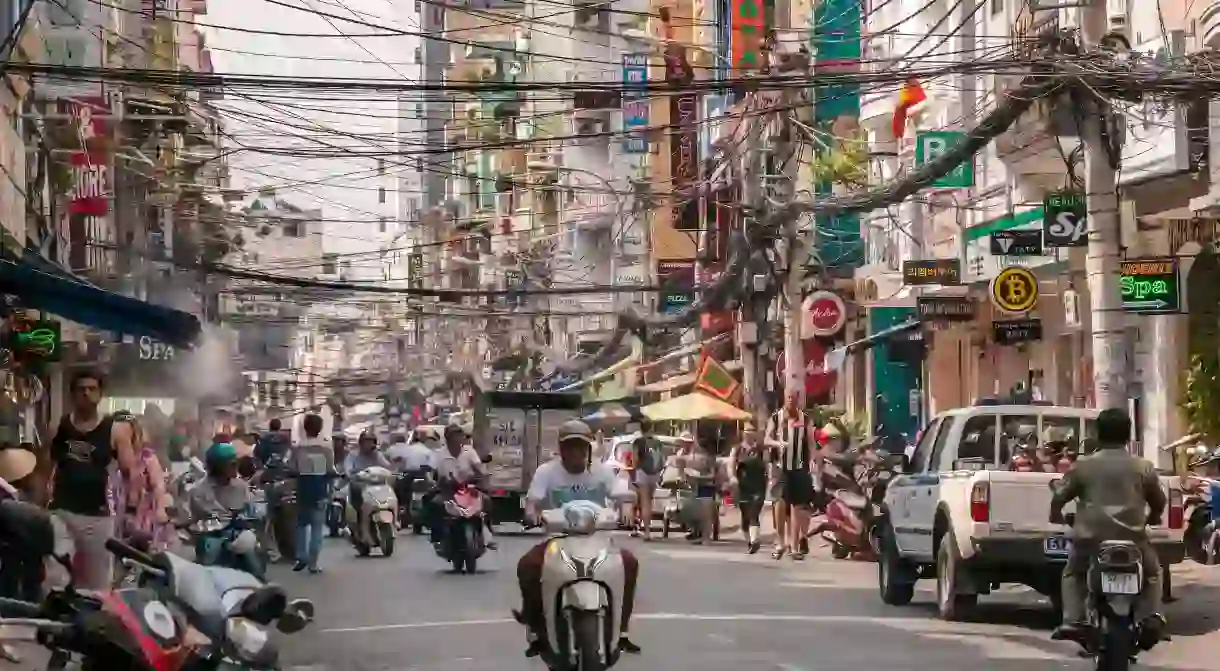The Last Sign Painter of Ho Chi Minh City

Electric signs may be have become the norm for shops and business around the world, but in Ho Chi Minh City one man is continuing his life’s work: hand-painted signage. Greg Lea meets Hoai Minh Phuong, an artist still going strong and bucking trends in his 70s.
His hand moves slowly and steadily. He grips the paintbrush lightly and presses it gently on the board in front of him. Each stroke is precise. Every few seconds, he takes a step back to survey his work, his eyes scanning from side to side as he considers his next move.
“This job is my joy,” he says. “As long as I’m still able to paint, it will forever be my joy.”
Hoai Minh Phuong has been living his passion for more than 30 years. It has not always been easy. Demand for his hand-painted signboards has fallen. As Ho Chi Minh City has grown richer, many businesses have moved towards electronic displays. The rise of the printing industry has made it easier than ever to mass-produce advertising posters. But still Mr Phuong continues on his own path.
He is 72 now. His mind remains sharp, but his body has grown frailer. His hands are rough, and his back is hunched. He cannot work as quickly as he once did.
Yet, when his brush touches the board in front of him, Mr Phuong comes alive. After all, this is all he has ever wanted to do.

A life’s work
“It all started when I was 14,” he explains. “One day I saw Hoa Hue, an artist, drawing on the street. I was captivated. He told me, ‘come by some time and I’ll teach you.’ I became his student. Mr Hue and another artist, Vu Trong Hop, encouraged me to follow my dream.”
There have been bumps in the road. Following the Fall of Saigon in 1975, most young men were forced to work for the government. Phuong was in his late 20s. He became an employee of a bus company in the city. It was only when the business dissolved a decade later that was Phuong free to turn his passion into his job.
He started with very little. It took years for him to build up his work space and expand his clientele. He started with small projects, but word of his talent gradually spread. Soon Mr Phuong was taking orders from restaurants, coffee shops and other companies throughout Saigon.
Business slowed in the 2000s as electronic signboards proliferated. It was a worrying period for Mr Phuong and his family. At times they struggled to get by. To save money, he collected scrap metal and discarded wood to make his boards, a practice he continues to this day.

Back in fashion
Now, though, the vintage look is back in fashion. Businesses are beginning to spurn the homogeneity of electronic signage in favour of Mr Phuong’s ingenious offerings.
“Life never stops changing,” he says. “People in Saigon are now looking back and appreciating what’s been forgotten. There’s no art in the same old electronic boards. Every hand painting is different. It requires talent, dexterity and emotion.
“I have more work now, but money is not important. We artists always live in poverty. That’s how we make meaningful art. We have experienced difficulties in life, we have felt pain, and we have overcome it.”
As one of the last of his kind, Mr Phuong has become well known for his work. He has collaborated with big brands like Marou, Vietnam’s foremost chocolatier. And he has even appeared on television, talking viewers through the creative process and showing off the fruits of his labour.
“There’s one problem with that,” Mr Phuong chuckles. “Every time I’m on TV, I’m asked to be well dressed. I find it uncomfortable. I’m a messy artist. I’m usually topless and I smoke cigarettes while I’m working. I stay up late and I drink too much coffee. You know, us artists are always skinny people. We often find that creativity comes with bad habits.”
His inventiveness extends beyond the canvas. Hoai Minh Phuong’s real name is Nguyen The Minh. The former is a nom de plume he adopted when he first began writing poetry at the age of 14. “I’ve been a poet my whole life,” he says, placing his coffee cup on the floor and taking a seat on a paint-splattered sofa. Almost 60 years later, he plans to release his first ever anthology, Memory of the Evening Rain.

A family business?
Mr Phuong has three adult sons. Neither the oldest nor the youngest shares his love of art, but his middle child is gifted and helps his father in the workshop.
That is just as well. It takes Mr Phuong at least three days to complete a signboard. The septuagenarian does not have the stamina he once did – but that doesn’t mean he is preparing to step aside any time soon.
“As I’ve grown older, my kids have asked me to retire,” he says. “They’re willing to take care of me for the rest of my life, to provide for me as I did for them.
“But that isn’t who I want to be; a retired man without a purpose, without direction. I’m not ready to give up my passion. An artist doesn’t stop following his dreams until his final breath.”













